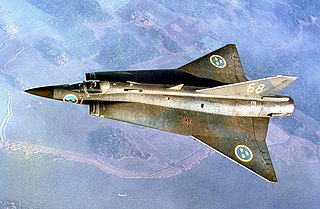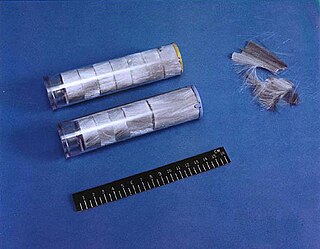British Aerospace plc (BAe) was a British aircraft, munitions and defence-systems manufacturer that was formed in 1977. Its head office was at Warwick House in the Farnborough Aerospace Centre in Farnborough, Hampshire. It purchased Marconi Electronic Systems, the defence electronics and naval shipbuilding subsidiary of the General Electric Company, in 1999 to form BAE Systems.

An anti-ship missile is a guided missile that is designed for use against ships and large boats. Most anti-ship missiles are of the sea-skimming variety, and many use a combination of inertial guidance and active radar homing. A large number of other anti-ship missiles use infrared homing to follow the heat that is emitted by a ship; it is also possible for anti-ship missiles to be guided by radio command all the way.

The Eurofighter Typhoon is a European multinational twin-engine, supersonic, canard delta wing, multirole fighter. The Typhoon was designed originally as an air-superiority fighter and is manufactured by a consortium of Airbus, BAE Systems and Leonardo that conducts the majority of the project through a joint holding company, Eurofighter Jagdflugzeug GmbH. The NATO Eurofighter and Tornado Management Agency, representing the UK, Germany, Italy and Spain, manages the project and is the prime customer.

The Saab 35 Draken is a Swedish fighter-interceptor developed and manufactured by Svenska Aeroplan Aktiebolaget (SAAB) between 1955 and 1974. Development of the Saab 35 Draken started in 1948 as the Swedish air force future replacement for the then also in development Saab 29 Tunnan dayfighter and Saab 32B Lansen night fighter. It featured an innovative but unproven double delta wing, which led to the creation of a sub-scale test aircraft, the Saab 210, which was produced and flown to test this previously-unexplored aerodynamic feature. The full-scale production version entered service with frontline squadrons of the Swedish Air Force on 8 March 1960. It was produced in several variants and types, most commonly as a fighter-interceptor.

The Meteor is a European active radar guided beyond-visual-range air-to-air missile (BVRAAM) developed and manufactured by MBDA. It offers a multi-shot capability, and has the ability to engage highly maneuverable targets such as jet aircraft, and small targets such as UAVs and cruise missiles in a heavy electronic countermeasures (ECM) environment with a range far in excess of 200 kilometres (110 nmi).

The fourth-generation fighter is a class of jet fighters in service from around 1980 to the present, and represents design concepts of the 1970s. Fourth-generation designs are heavily influenced by lessons learned from the previous generation of combat aircraft. Third-generation fighters were often designed primarily as interceptors, being built around speed and air-to-air missiles. While exceptionally fast in a straight line, many third-generation fighters severely lacked in maneuverability, as doctrine held that traditional dogfighting would be impossible at supersonic speeds. In practice, air-to-air missiles of the time, despite being responsible for the vast majority of air-to-air victories, were relatively unreliable, and combat would quickly become subsonic and close-range. This would leave third-generation fighters vulnerable and ill-equipped, renewing an interest in manoeuvrability for the fourth generation of fighters. Meanwhile, the growing costs of military aircraft in general and the demonstrated success of aircraft such as the McDonnell Douglas F-4 Phantom II gave rise to the popularity of multirole combat aircraft in parallel with the advances marking the so-called fourth generation.

Eurofighter Jagdflugzeug GmbH is a multinational company that coordinates the design, production and upgrade of the Eurofighter Typhoon military jet.

The Euroradar Captor is a next-generation mechanical multi-mode pulse Doppler radar designed for the Eurofighter Typhoon. Development of Captor led to the Airborne Multirole Solid State Active Array Radar (AMSAR) project which eventually produced the CAESAR, now known as Captor-E.

An active electronically scanned array (AESA) is a type of phased array antenna, which is a computer-controlled antenna array in which the beam of radio waves can be electronically steered to point in different directions without moving the antenna. In the AESA, each antenna element is connected to a small solid-state transmit/receive module (TRM) under the control of a computer, which performs the functions of a transmitter and/or receiver for the antenna. This contrasts with a passive electronically scanned array (PESA), in which all the antenna elements are connected to a single transmitter and/or receiver through phase shifters under the control of the computer. AESA's main use is in radar, and these are known as active phased array radar (APAR).

The Boeing F/A-18E and F/A-18F Super Hornet are a series of American supersonic twin-engine, carrier-capable, multirole fighter aircraft derived from the McDonnell Douglas F/A-18 Hornet, in service with the armed forces of the U.S., Australia, and Kuwait. The F/A-18E single-seat and F/A-18F tandem-seat variants are larger and more advanced versions of the F/A-18C and D Hornet, respectively.

The Eurofighter Typhoon is in service with nine nations: United Kingdom, Germany, Italy, Spain, Saudi Arabia, Oman, Qatar, Kuwait, and Austria, with orders for all nine customers still pending as of September 2017. The aircraft has, as of 2016, been provided in a basic air-defense form and has been upgraded to newer production standards which include internal IRST, air-to-ground precision strike capability, and HMSS helmets. Most of the major systems including the CAPTOR radar and the Defence Aids Sub-System (DASS) are expected to be improved and updated over time, with the radar being updated to an AESA, being the CAPTOR-E/CAESAR, of which the Kuwait Air Force will be the inaugural operator, with first deliveries of their 28 new-built aircraft to commence in 2019.

An electronic countermeasure (ECM) is an electrical or electronic device designed to trick or deceive radar, sonar, or other detection systems, like infrared (IR) or lasers. It may be used both offensively and defensively to deny targeting information to an enemy. The system may make many separate targets appear to the enemy, or make the real target appear to disappear or move about randomly. It is used effectively to protect aircraft from guided missiles. Most air forces use ECM to protect their aircraft from attack. It has also been deployed by military ships and recently on some advanced tanks to fool laser/IR guided missiles. It is frequently coupled with stealth advances so that the ECM systems have an easier job. Offensive ECM often takes the form of jamming. Self-protecting (defensive) ECM includes using blip enhancement and jamming of missile terminal homers.

The BAE Systems Mark 36 Super Rapid Bloom Offboard Countermeasures Chaff and Decoy Launching System is an American short-range decoy launching system (DLS) that launches radar or infrared decoys from naval vessels to foil incoming anti-ship missiles. The decoys present false signals and interference to the attacking missiles' guidance and fire-control systems.

An infrared search and track (IRST) system is a method for detecting and tracking objects which give off infrared radiation, such as the infrared signatures of jet aircraft and helicopters.

Chaff, originally called Window or Düppel, is a radar countermeasure involving the dispersal of thin strips of aluminium, metallized glass fiber, or plastic. Dispersed chaff produces a large radar cross section intended to blind or disrupt radar systems.
Radar jamming and deception is a form of electronic countermeasures that intentionally sends out radio frequency signals to interfere with the operation of radar by saturating its receiver with noise or false information. Concepts that blanket the radar with signals so its display cannot be read are normally known as jamming, while systems that produce confusing or contradictory signals are known as deception, but it is also common for all such systems to be referred to as jamming.

This is the timeline of the development of the Eurofighter Typhoon, a multirole fighter aircraft manufactured by a consortium of European aerospace manufacturers, Eurofighter GmbH, formed in 1983.

Chemring Group plc is a global business providing a range of advanced technology products and services to the aerospace, defence and security markets. Chemring has extensive operations in the Americas, Europe, Middle East and Asia.
The AN/ALE-47 Airborne Countermeasures Dispenser System is used to protect military aircraft from incoming radar and infrared homing missiles. It works by dispensing flares or chaff. It is used on a variety of U.S. Air Force, Navy, and Army aircraft, as well as in other militaries.

BriteCloud is a self-contained expendable Digital Radio Frequency Memory (DRFM) jammer developed by Selex ES to help protect military aircraft. The decoy was launched by Selex ES at a conference held at the Churchill War Rooms, London on 6 November 2013.



















